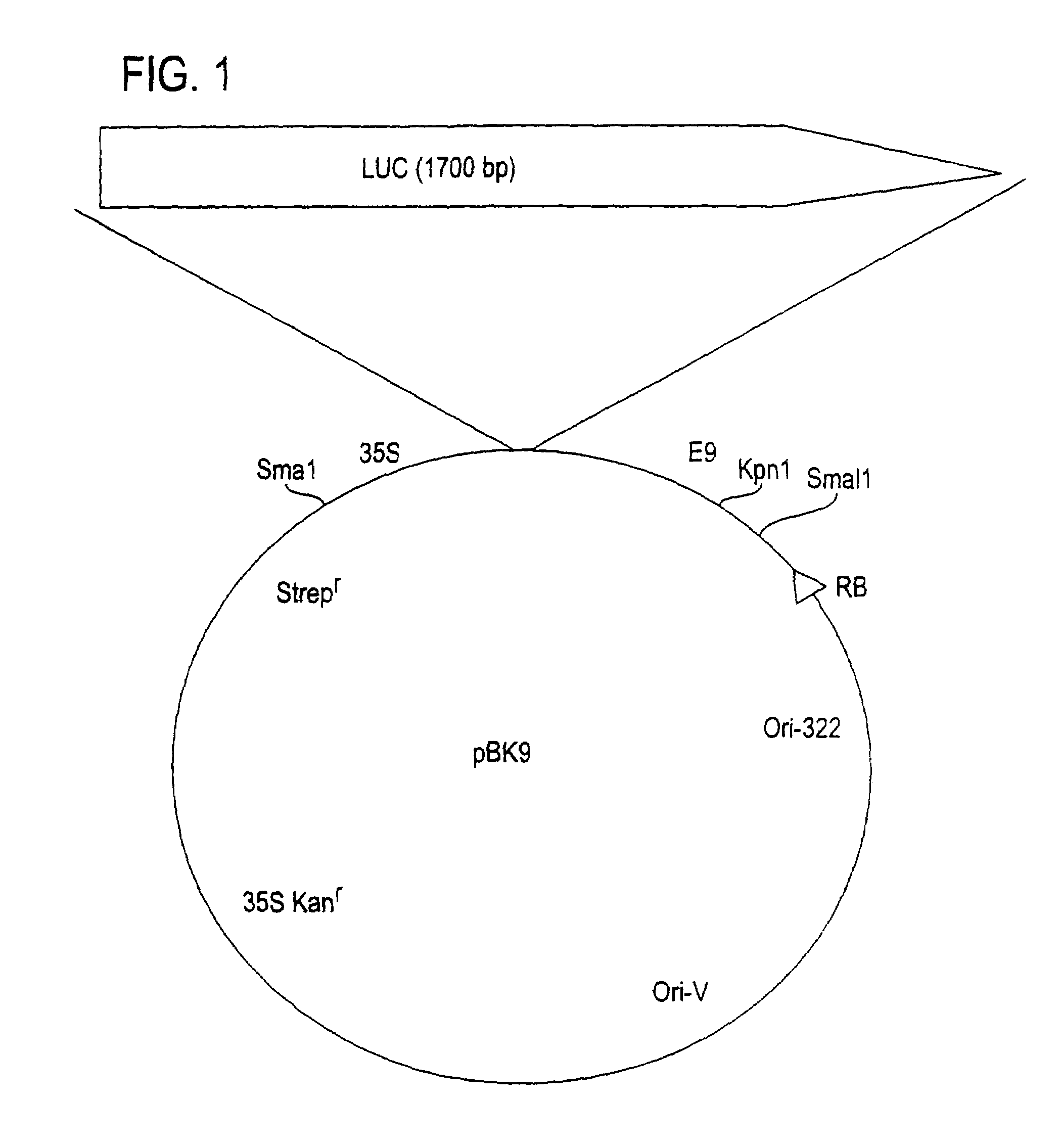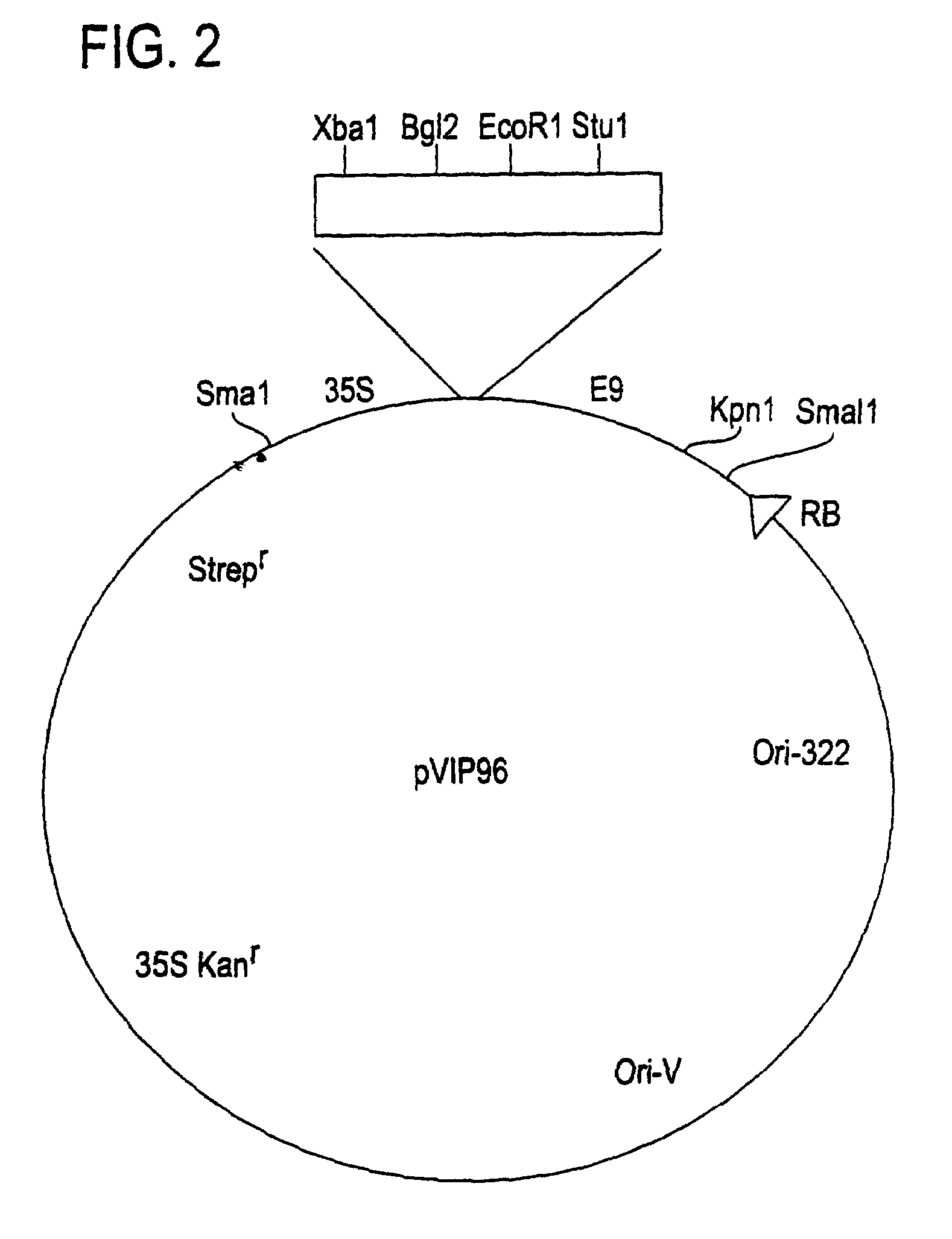Agrobacterium-mediated transformation of cotton with novel explants
a technology of agrobacterium and cotton, applied in the field of gene engineering of plants, can solve the problems of difficult elimination of i>agrobacterium /i>during subsequent elimination, and achieve the effect of wide application and improved transformation ra
- Summary
- Abstract
- Description
- Claims
- Application Information
AI Technical Summary
Benefits of technology
Problems solved by technology
Method used
Image
Examples
example 1
Regeneration of Cotton Plants from Root Tissue Culture
[0033]Preparation of Root Explants: Cotton Seeds were sterilized in 70% ethanol for 10-15 min., and then treated with 10% H2O2 for 30-120 mins. Treated seeds were rinsed in sterile water for 24 hrs at 28° C. and germinated on either CB-1.1 medium or CB-1.2 medium at 28° C.-30° C., 16 h light (60-90 μE m−2 s−1) Seven to ten days sterile seedlings thus grown were used to prepare explants. It was found that plentiful healthy roots (longer and thicker) with white color were obtained using CB-1.1 medium, whereas shorter and thinner roots with grey to brown color were obtained using the CB-1.2 medium. Therefor, CB-1.1 was chosen for further work.
[0034]Induction of calli: Fibrous roots were cut from seedlings and cultured on CB-2.1 medium or CB-2.2 medium at 28° C.-30° C. for three days, 16 h light (60-90 μm2 s−1). The optimum size for root explants was 5-7 mm. A few small calli initiated on the cut sites of root segments in as little a...
example 2
Agrobacterium Transformation and Culture
[0036]The plasmid pBK9 (35S:LUC) (see FIG. 1) was generated by cloning the luc coding sequence from the BamHI / Stul fragment of plasmid pGEMluc into the blunt-ended Stul site of the plasmid pVIP96 (see FIG. 2).
[0037]Prepared competent cells (400 microliter) in Eppendorf tube from −80° C. were put on ice to thaw. Plasmid DNA was added in the cells. After gentle mixing, the mixture was incubated on ice for 45 minutes. The Eppendorf tube containing the mixture was put into liquid nitrogen for 1 minute and afterwards in a water bath (37° C.) for 3 minutes. After the incubation, 800 microliter LB medium (without antibiotics) was added into the mixture and the tube with the mixture was incubated at 28° C. for 3 hours. After a brief centrifugation at 12,000 rmp, 800 microliter supernatant was removed. The rest of the medium was mixed well with the cell pellet and the mixture was plated onto LB plates containing 100 mg / L kanamycin and 100 mg / L streptom...
example 3
Transformation of Root Explant Tissue and Regeneration of Transgenic Cotton Plants
[0038]Root explants were obtained by cultivating sterile cotton seeds as described in Example 1, above, on CB-1.1 medium. Fibrous roots were cut from seedlings and cultured on CB-2.2 for two days, 16 h light (60-90 μE m−2s−1). The fibrous roots were then cut into small segments (5-10 mm) and incubated with the cell suspension culture of Agrobacterium tumefaciens strain LBA4404 harboring the plasmid pBK9 (35S:LUC) (A600=0.1-0.6) of Example 2 for 15 min. After drainage of the bacterial solution, the root explants were cultured at 28° C., 16 h light (60-90 μE m−2s−1) for an additional two days. The optimum concentration of the Agrobacterium strain LBA4404 for root explants was lower (A600=0.1-0.4) than that for hypocotyl and cotyledon explants (A600=0.3-0.6). Optimal bacterial concentrations did not affect the growth of the root explants and the subsequent callus induction.
[0039]Co-cultured explants were ...
PUM
| Property | Measurement | Unit |
|---|---|---|
| Concentration | aaaaa | aaaaa |
| Concentration | aaaaa | aaaaa |
| Density | aaaaa | aaaaa |
Abstract
Description
Claims
Application Information
 Login to View More
Login to View More - R&D
- Intellectual Property
- Life Sciences
- Materials
- Tech Scout
- Unparalleled Data Quality
- Higher Quality Content
- 60% Fewer Hallucinations
Browse by: Latest US Patents, China's latest patents, Technical Efficacy Thesaurus, Application Domain, Technology Topic, Popular Technical Reports.
© 2025 PatSnap. All rights reserved.Legal|Privacy policy|Modern Slavery Act Transparency Statement|Sitemap|About US| Contact US: help@patsnap.com


